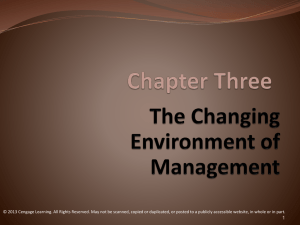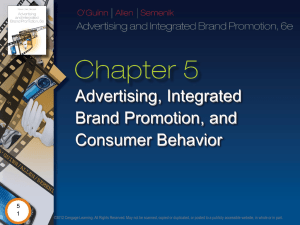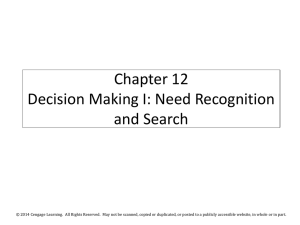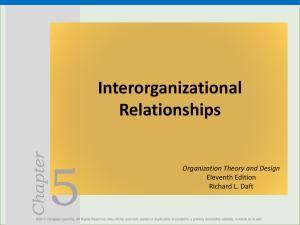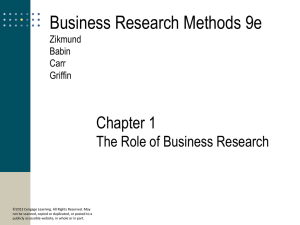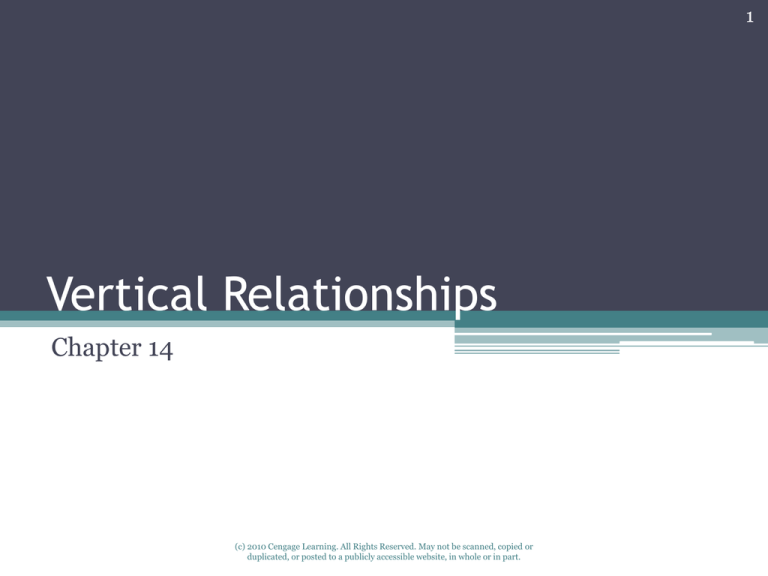
1
Vertical Relationships
Chapter 14
(c) 2010 Cengage Learning. All Rights Reserved. May not be scanned, copied or
duplicated, or posted to a publicly accessible website, in whole or in part.
2
(c) 2010 Cengage Learning. All Rights Reserved. May not be scanned, copied or
duplicated, or posted to a publicly accessible website, in whole or in part.
3
The Ore Carrier
U.S. Steel Corporation’s Roger Blough (rhymes with “how”) is a type of boat seen
only on the Great Lakes. She (ships are still gendered female) is an iron ore
carrier. Why does U. S. Steel own the Roger Blough (named after a former
executive), the ore mine and the processing facility?
(c) 2010 Cengage Learning. All Rights Reserved. May not be scanned, copied or
duplicated, or posted to a publicly accessible website, in whole or in part.
4
What’s Next?
In this chapter we explore why U.S. Steel and other firms are
vertically integrated. We will examine how businesses
determine the activities they will perform in-house and those
for which they will rely on outsiders. A management’s
decision on the vertical scope of its business is as important
as its decision on the good or service to produce.
(c) 2010 Cengage Learning. All Rights Reserved. May not be scanned, copied or
duplicated, or posted to a publicly accessible website, in whole or in part.
5
(c) 2010 Cengage Learning. All Rights Reserved. May not be scanned, copied or
duplicated, or posted to a publicly accessible website, in whole or in part.
6
Goods (or Services) in Process
This figure shows how about 50
percent of America’s steel is
currently produced. It
summarizes the vertical steps in
steelmaking. An earlier step is
called upstream and a later one
downstream. A firm that controls
several steps is vertically
integrated. The alternative to
integration is a contract or
market relationship in which a
downstream firm buys an
upstream producer’s output.
(c) 2010 Cengage Learning. All Rights Reserved. May not be scanned, copied or
duplicated, or posted to a publicly accessible website, in whole or in part.
7
Transaction Costs and Vertical
Integration
Volumetric Interdependence: The production and milling of
hot steel have a high volumetric interdependence. The blast
furnace must produce just enough pig iron for steelmaking, and
at just the right times. If coordination fails and the liquid
solidifies, reheating is costly.
Adapting to Uncertainty: If different people own the furnaces
and mill they face risk-sharing problems like the pin producers
of Adam Smith. A complete contract that handles all possible
risks will be impossibly costly to write and enforce.
(c) 2010 Cengage Learning. All Rights Reserved. May not be scanned, copied or
duplicated, or posted to a publicly accessible website, in whole or in part.
8
Opportunism, Thin Markets, and
Vertical Integration
Integrated Ore Mines and Shipping: Transaction costs,
uncertainty, and risks of opportunism can also explain why
U.S. Steel owns its mines, enrichment facilities, and ore
carriers.
Unintegrated Coal Mines: But although U.S. Steel is
integrated into iron mining, it currently does not own any of
the mines that supply its coking coal. Coal is a less specific
resource than iron ore; it trades at competitive prices, and U.S.
Steel can hedge any remaining risks without having to own
mines.
(c) 2010 Cengage Learning. All Rights Reserved. May not be scanned, copied or
duplicated, or posted to a publicly accessible website, in whole or in part.
9
Changes in Vertical Integration
How Steelmakers Became Integrated: Economies of scale drove firm sizes
upward, and the Bessemer converter’s operating characteristics motivated
their integration into mining.
Why Steel Is De-integrating Today: Mini-mills fill an electric furnace
with scrap steel, feed in high-voltage power, and in as little as two hours
the scrap will be melted and ready for casting. Like an integrated
producer’s, a mini-mill’s volumetric interdependence explains the
integration of its casting and milling activities. There are, however, few
reasons for a mini-mill to own a source of scrap steel, which trades in a
worldwide market with many competing sellers.
Demand-Driven Changes: Looking at another industry, most meats and
vegetables were once produced by independent farmers, who sold them in
spot markets to independent packers or grocers. Economies of scale
became pervasive over the twentieth century for some farm products.
(c) 2010 Cengage Learning. All Rights Reserved. May not be scanned, copied or
duplicated, or posted to a publicly accessible website, in whole or in part.
10
Summary: Principles of Integration and
Separation
A firm chooses vertical integration if doing so reduces costs
below those it would incur in markets. This table shows how
different degrees of asset specificity and uncertainty can
affect the choice of markets, contracts, or integration.
(c) 2010 Cengage Learning. All Rights Reserved. May not be scanned, copied or
duplicated, or posted to a publicly accessible website, in whole or in part.
11
(c) 2010 Cengage Learning. All Rights Reserved. May not be scanned, copied or
duplicated, or posted to a publicly accessible website, in whole or in part.
12
Mergers and Agreements - Successive
Monopolies
Jones is a nondiscriminating monopolist who produces good
A. Assume that his only cost is for input B, and it takes a unit
of B to produce a unit of A. Unfortunately Jones’s only source
of B is Smith, who is also a single-price nondiscriminating
monopolist. A and B are produced by successive monopolies
that face the problem of double marginalization. If they
operate independently their joint profits are smaller than if
they cooperate. They can solve the problem by merging or
devising a contract.
(c) 2010 Cengage Learning. All Rights Reserved. May not be scanned, copied or
duplicated, or posted to a publicly accessible website, in whole or in part.
13
Mergers and Agreements – Price
Discrimination
The Aluminum Company of America (Alcoa) had a near
monopoly in the United States during the first half of the
twentieth century. Alcoa sells aluminum to aircraft producers
whose demand is inelastic and to cookware manufacturers
whose demand is elastic. Alcoa would benefit from charging
Different prices to these customers, however, they could not
prevent cookware producers from ordering large volumes of
aluminum and reselling some to aircraft manufacturers. The
company solved its problem by vertically integrating into
cookware production.
(c) 2010 Cengage Learning. All Rights Reserved. May not be scanned, copied or
duplicated, or posted to a publicly accessible website, in whole or in part.
14
Mergers and Agreements - Avoiding
Price Controls
Gas sells in a competitive market, and there are no controls
on its price. The maximum rates pipelines can charge,
however, are set by the federal government. During peak
periods, however, demand at the maximum price can exceed
available capacity. A buyer willing to pay more has the option
to arrange a “buy-sell” transaction with the pipeline. In a
buy-sell the pipeline offers to resell gas it purchased in the
market for a higher price than it paid. By integrating into gas
production or contracting with a producer the pipeline
evades the legal ceiling on its transportation charge.
(c) 2010 Cengage Learning. All Rights Reserved. May not be scanned, copied or
duplicated, or posted to a publicly accessible website, in whole or in part.
15
Mergers and Agreements – Obtaining
Market Information
Assume that your firm uses large amounts of some input,
which you buy from several different producers without
facing transaction costs or opportunism that might
otherwise warrant vertical integration. The prices you pay
are individually negotiated, but you may be at a
disadvantage because you do not know the producers’ true
costs and may be paying more than you have to. To gain
information, you might consider integrating into the
production of this input, not just to obtain part of your
supply but also to better estimate the costs of other
producers.
(c) 2010 Cengage Learning. All Rights Reserved. May not be scanned, copied or
duplicated, or posted to a publicly accessible website, in whole or in part.
16
Vertical Restraints - Complementary
Skills and Competition
The steps in a vertical chain may require quite different
resources and skills. Ford Motor Company designs, produces,
and nationally advertises its cars, but an actual sale requires
effort by a local dealer. In cases like these an agreement that
assigns responsibilities to different parties could
turn the organization into a stronger competitive entity than if
all of the responsibilities. One common agreement is a
franchise contract between a parent company (the franchisor)
and the operator of a local outlet (the franchisee), specifying
each party’s duties and the structure of payments that will link
them.
(c) 2010 Cengage Learning. All Rights Reserved. May not be scanned, copied or
duplicated, or posted to a publicly accessible website, in whole or in part.
17
Vertical Restraints - Free Riding
Like all contracts, franchising is subject to risks of
opportunism. These risks can be aggravated by the fact that a
brand name has some properties of a public good. A full
enumeration of all possible opportunistic behaviors may be
impossible, but the success of the brand requires the parent
company to be able to sanction franchisees who are not
making the expected effort.
(c) 2010 Cengage Learning. All Rights Reserved. May not be scanned, copied or
duplicated, or posted to a publicly accessible website, in whole or in part.
18
Vertical Restraints - The Structure of a
Franchise Contract
A franchise contract must reward sales efforts by the franchisee while
acknowledging that any relationship between effort and results is
inexact. The contract must thus be structured to motivate the franchisee.
Franchisor and franchisee are in a principal-agent relationship with the
same types of monitoring problems and risks of opportunism we
previously encountered. To lessen them, many franchise contracts have
similar structures:
• the franchisee pays a fixed annual fee for the right to operate.
• the franchisee pays a royalty, usually a monthly payment that
averaged 5.1 percent of gross revenue in 2001
(c) 2010 Cengage Learning. All Rights Reserved. May not be scanned, copied or
duplicated, or posted to a publicly accessible website, in whole or in part.
19
(c) 2010 Cengage Learning. All Rights Reserved. May not be scanned, copied or
duplicated, or posted to a publicly accessible website, in whole or in part.
20
The Decision to Outsource
The logic of vertical integration is also the logic of deintegration, nowadays often called “outsourcing.” It has grown
steadily over the last half of the twentieth century in all
industrialized nations.
(c) 2010 Cengage Learning. All Rights Reserved. May not be scanned, copied or
duplicated, or posted to a publicly accessible website, in whole or in part.
21
The Decision to Outsource
Asset specificity and uncertainty are major factors in deintegration, but they act in opposite directions. A
management’s choice to outsource also depends on its ability
to evaluate and compare external to internal performance.
When activities are common and standardized, and few
investments on either side are specific to a relationship with a
particular provider, outsourcing is a good option.
(c) 2010 Cengage Learning. All Rights Reserved. May not be scanned, copied or
duplicated, or posted to a publicly accessible website, in whole or in part.
22
The Decision to Outsource
Change the task and outsourcing becomes more difficult.
Assume that the design of your firm’s products must
constantly change if the firm is to maintain its edge over
competitors. Design and engineering require contact with
customers, intelligence about competitors, and familiarity
with the details of your own manufacturing process. You are
unlikely to outsource designing or manufacturing for several
reasons.
(c) 2010 Cengage Learning. All Rights Reserved. May not be scanned, copied or
duplicated, or posted to a publicly accessible website, in whole or in part.
23
Some Trends to Explain
It is hard to estimate the overall importance of vertical
integration in an economy, but evidence points to a general
decrease since the 1970s. Firms encompass fewer stages of
production, and market transactions are replacing activities
that formerly took place inhouse.
The largest single employer in the country is not General
Motors, but a temporary employment agency called
Manpower Inc. The largest owner of passenger jets is not
United Airlines, or any other major carrier, but the aircraft
leasing arm of General Electric.
(c) 2010 Cengage Learning. All Rights Reserved. May not be scanned, copied or
duplicated, or posted to a publicly accessible website, in whole or in part.
24
Some Trends to Explain
Functions formerly undertaken within a firm are being
replaced by transactions between firms, and they often cross
national boundaries in the process. In 1998, 30 percent
of the dollar value of a typical American cars (that is, brands
first manufactured in the United States) originated in Korea,
17.5 percent in Japan, 4 percent in Taiwan andSingapore, 2.5
percent in the United Kingdom, and 1.5 percent in Ireland
and Barbados. Only 37 percent came from the United States.
(c) 2010 Cengage Learning. All Rights Reserved. May not be scanned, copied or
duplicated, or posted to a publicly accessible website, in whole or in part.
25
Some Trends to Explain
Statistics on international commerce point to the rise of
de-integration. Trade in components of final goods
(those sold to ultimate users) has grown faster than
trade in the goods themselves.
(c) 2010 Cengage Learning. All Rights Reserved. May not be scanned, copied or
duplicated, or posted to a publicly accessible website, in whole or in part.
26
Why the Change? - Markets and
Information
Markets increase the likelihood of finding trades that create more
economic value. Air travel and telecommunications reduce the costs of
meeting others and moving goods, as well as transaction costs like credit
checking, translation, and visual inspections. The changes have helped to
establish markets where people need no longer actually meet.
Technological and social changes have lowered other costs of using markets.
The growth of international commerce is standardizing both containers and
contracts. Commercial laws are being harmonized and their terminology
standardized for greater ease of making contracts and settling disputes.
(c) 2010 Cengage Learning. All Rights Reserved. May not be scanned, copied or
duplicated, or posted to a publicly accessible website, in whole or in part.
27
Why the Change? - Information, Scope,
and Scale
This figure shows two long-run
average cost curves.
The first, LRAC1, portrays a firm’s
costs before the arrival of
inexpensive information
technology (IT), such as personal
computers and inexpensive
telecommunications. As industries
adopt these less expensive, smallerscale IT applications, the optimal
size of firms will shrink.
(c) 2010 Cengage Learning. All Rights Reserved. May not be scanned, copied or
duplicated, or posted to a publicly accessible website, in whole or in part.
28
Why the Change? - Internal and
External Coordination
The full effect of the new technology on a firm’s size and scope
will depend on what happens to the benefits of internal
relative to external coordination. Some types of technology and
software may decrease the costs of internal coordination and
make larger firms more efficient.
If IT increases the net benefits of external coordination
by more than those of internal
coordination, its vertical scope will shrink and so will
its size.
(c) 2010 Cengage Learning. All Rights Reserved. May not be scanned, copied or
duplicated, or posted to a publicly accessible website, in whole or in part.



